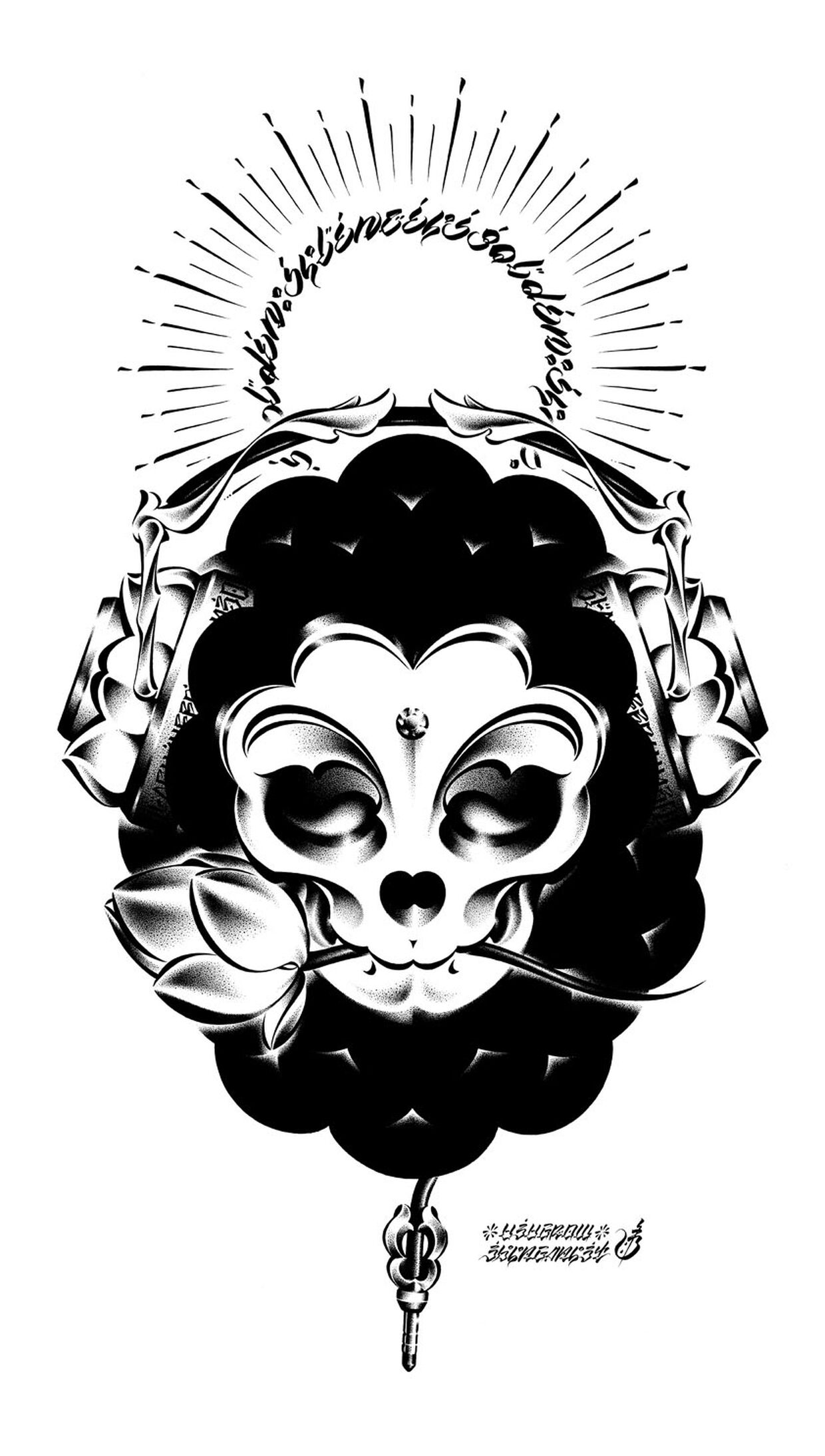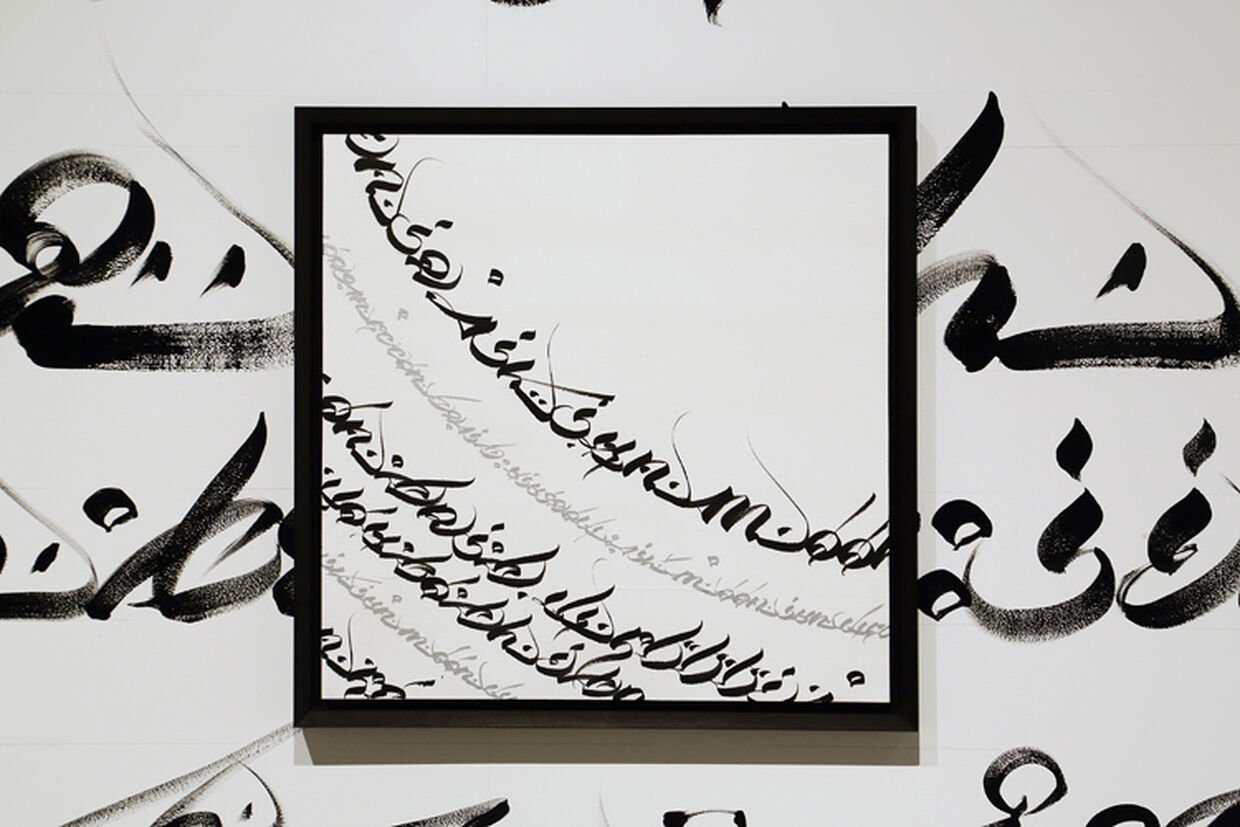--Please introduce yourself.
I am usugrow.
--Tell us about the concept and highlight of the exhibition.
There is no particular concept. I did drew a new piece, but I would like people to enjoy what I have made and what I have been working on. I suppose that everyone has their own image of skull and lettering because they have been a typical motif. However, I hope that people enjoy something unexpected, feel empathy, and accept the various interpretations.
--Tell us how you usually develop your artwork.
I just do normal stuff. Draw a rough sketch with pencil and finalize with ink and sumi. I always listen to music while drawing, and I select the suitable music according to what I draw. I sometimes make a special playlist based on the image recently.
-- When do you most likely come up with the idea of your artwork? What is your inspiration?
To be honest with you, it's not like I get inspiration by interacting with nature while drinking coffee and reading book, it's not as highbrow as you think. Because I'm always facing the pressure of a deadline, I kinda squeeze out an idea instead of stumbling across. I hungrily see lots of things and listen to various things. It's like I make a pig of myself until I get satisfied. Then I am always having a dialogue with myself.
As for personal piece, I mostly get inspirations from history or religious outlook. Ethnic music and painting, book and character and script from ancient people gives me incentive. When I am asked for a commissioned work, I sometimes ask for what client wants me to draw. I wouldn't accept everything what they said, but I often study and get new ideas from what I newly learn.
--How did you get interested in art? What made you decided to become an artist?
I first got interested in hardcore and slash metal music when I was around 16 years old. I got interested in its music but also the flyer, vinyl record and album cover. Then I started drawing, and I did friends' band's flyers and cassette labels first. In this particular music scene, it's nothing special to create music and artwork, and do a show by our own (DIY) regardless of pro or amateur. Artworks for this type of music can be often created by their friend or band member. Whatever turns out good is good for us, and everyone supports it. We don't need any qualification or education background to start off your art. It's always free to either start or quit and it's really up to you and people judge you only by style. I really liked this simple DIY ethic.
--What is the reason that you mostly draw a skull in black and white?
In order to make a photo copy of live flyers cheap, I made my work in black and white, to look very sharp even if it's cheap black and white copy. Around the time of 1992 or 93, there was no PC and we couldn't afford to use color printer and color copy. Printing cost around that time was quite expensive. At that time, I was printing T-shirt by my own by using silk screen. I made a stipple black and white gradation, so I only need one screen. This was another reason. The music scene I immersed was very small in terms of budget, so this was nothing special.
And in this music scene, skull was very typical motif and a lot of artists was drawing. I used to like a skull artwork too but I didn't want to do anything that others do, so I used to draw buddhist statue, flower, Yokai (specter), Japanese style pattern that I liked. After I kinda developed my style I started drawing a skull, and that was around 2000. I started doing a lot of thinking about skull. I started wondering why people treat a skull as negatively even though everyone has. I still have an abiding interest in skull, so I am still drawing.
--Some of them have a skull face but been combined with human-like body parts or bodily movement, tell us about it.
It depicts the space between afterlife and reality, space between life and death. Same goes for the skull combined with a living face. When I used to draw buddhist statue, specter, or heteromorphic human, I had them carry a skateboard, or wear the same shirt and shoes that I wore. Perhaps, I like drawing the world between afterlife and reality.
--Your old artworks included in "FLYER ARTWORK 1994-2004" and your latest artworks have quite different style. What triggered a change?
Maybe it's because things I was interested in at that time or how I feel about things have changed. As for the change of motif, it gradually changed from buddhist statue, flower, specter, something heteromorphic to something fierce or dark. After I kinda got tired of negative dark things such as cult, I had a chance to sort out my life, then I started having an interest in flower, buddhist statue and soft lines again. Another thing is that the way to express anger to, for example, kids or adult may be different. You can start controlling your emotion to express your anger by using soft voice, instead of emotive words.
--How long does it usually take to complete a stipple drawing?
It takes about three to four weeks to complete. If there is no deadline, I would probably never stop working on, so I can't really say how long.
--Tell us about your calligraphy piece. What kind of thinking or words are you writing?
I am currently writing things that I am thinking, by questioning others how about this. If someone is interested in what's written, I can explain. It's not like I am trying to hide, but I don't explain in concrete terms here. If you want to know, just come to the gallery or ask me directly.
--You have been very active across the world. Do you find any difference how people feel and react depending on their nationality or culture?
It's not nationality, it's more like regional characteristic and culture of where they live. People usually get surprised by the fineness of stipple and how I treat frame and paper in a careful manner anywhere in the world. I would say, there are two regions, where people ask me about skills, and where people ask me about view of the world and story. Maybe this explains how people see art in each regions.
--What is your impression about current Japanese art scene?
I have no interest in art scene, or perhaps I should say I don't really know since I don't belong there. However, I think that standards of what's good and who's nice have been drastically changed these days. I guess alchemy does not work anymore by using whole bag of tricks.
-- If you were to choose your favorite piece from your collection, what would it be?
I'm emotionally attached to all the artworks I had made, so all of them are my favorite. I don't get obsessed to keep things, so I will let them go.
-- You are also running your own HHH gallery with your friends. What is the concept and purpose of the gallery?
I wanted to have the space to introduce the artists that I like. It's bit hard to manage both activities, but it's very similar when I organize some projects. Like I used to exchange a demo tape with my favorite band, trade a copy of artwork, and book a show in music scene, I am still doing the same thing now.
--Do you have any artists that you respect?
I can't name any specific person, but I respect the person who does not afraid of changing. It does not matter if he or she leaves his name in art history or not, I like the person who ends up being loved by ordinary people. The person who talks too much about art context is simply out of the question.
--Tell us about the book, movie, music that you have been influenced by
Like I said earlier, I first got influenced by flyer, record, CD from hardcore music scene. In recent years, I listen to various music, especially ethnic music or works of the musician who has such elements. Like musicians who are engaged in a dialogue with ancient and modern times.
For book, I still look at the photo book "Japanese Buddha Statue" by photographer Ken Domon which I bought twenty years ago. When I looked at his book, all the Buddha statues that I used to look at schoolbook look totally different. I don't really watch a movie but I used to like TV commercial. It's interesting to see a few seconds movie filled with the information which needs to be conveyed. I used to go to the screening of CM festival.
--How do you spend your day off?
I don't have any specific day off. I appreciate the situation that I can now do the things that I've been wanting to do since teenager. So I feel bit guilty of taking a day off.
--Please tell us about your upcoming project or anything that you would like to try next.
I would like to learn the basic. Basic of drawing and how to use paint and sumi. Since I've learned to draw on my own, I sometimes reach my limit in terms of technique. What I would like to try next is movie making. There are so many equipments and software that we can use, and we can show them on website. Compared with the time that I used to make black and white photo copy, we are living in good times as we have so many options and tools.
--Do you have any message to the people who came to ORGANIC CONTRAST - Artworks of Usugrow exhibition?
Thank you all for coming. I hope this show cheers you up or gives you some opportunities.













